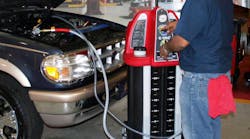It’s no surprise that fuel is often one of a fleet’s largest expenses, since a typical Class 8 truck can consume anywhere between $40,000 and $70,000 worth of fuel annually. One way to mitigate fuel cost is to specify the vehicle to strike a balance between fuel efficiency and performance. Optimized specifying for heavy duty commercial trucks could pay dividends to a fleet’s bottom line over the life of a vehicle.
Specifying a vehicle for optimal fuel efficiency is not a one-size-fits-all approach. Variables such as type of load, length of haul, driver behavior, and geographic operating area all play a factor in specifying a truck that’s right for a fleet’s unique application.
There are a wide variety of options to choose from such as aerodynamic skirts and fairings, low-rolling resistance tires, idle reduction technologies, and lightweighting specs. Additionally, all fleets can benefit from an optimized powertrain to help deliver top fuel mileage.
What powertrain components should be taken into consideration when specifically looking to run an engine at its most efficient speed? Since the entire system works together – the engine, transmission, driveline, and rear axles – it’s important to look at the entire system as a whole. Each powertrain component is available in many different options that all have trade-offs in fuel economy and performance. By specifying all the components that make up the overall system, the maximum synergy can be achieved.
Powertrain basics
There are a number of areas where the powertrain efficiency can be improved. Here are some of those options:
Downspeed engine ratings
Downspeed engine ratings can easily boost fuel economy. When the engine operates at a lower rpm at the same vehicle speed, engine friction and pumping losses are reduced. For example, the amount of energy to pump coolant and oil are less at lower engine speeds, reducing pumping losses.
Rear axle ratio
The rear axle ratio is absolutely critical for attaining optimal fuel economy. A lower rear axle ratio works in conjunction with a downsped engine rating to maximize fuel efficiency.
Multi-torque engine ratings
Multi-torque models allow the engine and transmission to work together to select the optimal torque curve. This improves fuel efficiency by only providing maximum torque in the top two or three gears, which encourages the driver to operate in the highest available gear for the highest efficiency.
Powertrain options
A good initial spec can help fleets operate more profitably and efficiently, but understanding the factors that affect fuel economy is critical to achieving the best results.
Engine ratings
Engines are available in a wide range of horsepower and torque ratings. Certain ratings favor fuel economy over performance. These fuel efficiency-focused ratings are typically available at 400 and 450hp, providing higher torque at lower rpm.
On/off fan clutch versus two-speed (long haul applications)
Fan operation can significantly affect fuel economy. After all, the more time spent with the fan on, the more power required from the engine, and the less power the engine has to move. The on/off fan clutch is recommended primarily for fleets that spend roughly 80 percent of their time on-highway, as it doesn’t require torque when the fan is off. Two-speed fan clutches use engine torque, even when the fan is off. Less frequent cycling of the fan clutch can also extend fan clutch life.
FA-4 versus CK-4 engine oil
Lubricant maintenance is crucial to the performance and functionality of an engine. FA-4 is an available factory fill option on the International A26 engine. In our testing, FA-4 10W-30 oil improved A26 fuel efficiency by 0.7 percent over CK-4 10W-30 oil. For customers looking to maximize oil drain intervals with an oil sampling program, FA-4 oil can help to achieve reduced maintenance expenses.
FA-4 is suitable for use in 2017 GHG-certified engines. CK-4 is a high-temperature, high-shear oil that can be used in both new and existing engines. FA-4 and CK-4 are interchangeable while topping off and at oil changes, providing the same engine durability and oil drain interval.
High-efficiency rear axles
High-efficiency rear axles are optimized to minimize internal friction. High-efficiency axles are available in a variety of configurations from multiple axle manufacturers to meet the needs of any specific applications most efficiently.
Emgard XFE Synthetic rear axle lubricant
The use of Emgard XFE Synthetic rear axle lubricant can provide up to 0.25 percent better fuel efficiency. It’s available with a range of rear axles and is specifically engineered to minimize friction within the rear axle.
6x4 versus 6x2 axle configuration
In a 6x4 configuration, both of the tractor’s rear axles are drive axles. A 6x4 configuration is better suited for a vehicle that needs to deliver power to more tires in order to provide better traction. In a 6x2 configuration, only one of the two rear axles receives power. Using a 6x2 configuration can be up to 2 percent more fuel efficient, and is best suited for trucks that operate on paved roads with moderate grades. A 6x2 configuration also has fewer driveline components, which can reduce maintenance and increase vehicle uptime.
Programmable parameters
When parameters are optimized in a few key areas such as maximum vehicle acceleration speed and enabled progressive shift and idle shutdown mode, fleets may experience improved fuel efficiency.
Predictive cruise control
Predictive cruise control (PCC) recognizes when the vehicle should accelerate or decelerate before grades to avoid downshifts and minimize braking to maximize fuel efficiency, so it’s most effective when used on predominantly hilly terrain. PCC can offer up to 2 percent better fuel efficiency and can be further utilized to reduce fuel and diesel exhaust fluid (DEF) consumption when programmable parameters are set to allow for a wider range of vehicle speed above and below set speed.
Coast feature
A coasting function is available on many newer engines. Coasting can save fuel by shifting the transmission into neutral when descending a shallow grade. A feature like this could boost fuel efficiency 0.5 percent or more.
Automated manual transmissions
Automated manual transmissions (AMTs) improve fuel efficiency by ensuring shifts occur at optimal engine speeds, thus making every shift the most fuel efficient. Additionally, the ability to computer-control gear shifts via an AMT can lengthen clutch life.
Conclusion
With so many fuel-efficient technologies available today, and more technologies coming, it can be overwhelming to specify a truck to have the best productivity and lowest cost per mile for its specific application. Beginning with a properly specified truck will make for years of happy driving and improved total cost of ownership.







